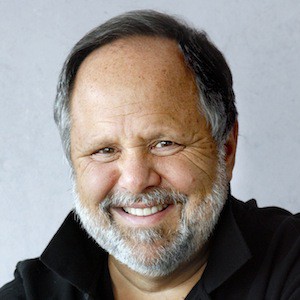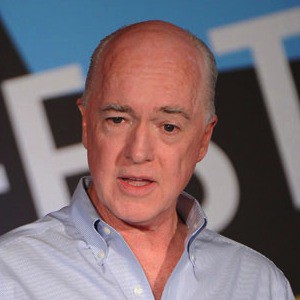Martin Nisenholtz: We’re here at the offices of the “Financial Times,” with Rob Grimshaw, on, I think it’s the 18th of April.
Rob Grimshaw: It is, indeed, the 18th, yeah.
Martin: 18th, here in New York. Martin Nisenholtz interviewing Rob. Rob, let’s just start with a very simple background question. I want to start with a caveat, actually. I apologize. This project is pretty much contained to US companies.
The reason we’re interviewing someone from the “FT” is because the “FT” has had the most material effect on the business model today, with its pioneering of the metered model. The “Times” took that model. Many other newspapers, hundreds of other newspapers, now have taken it.
That’s the caveat, for those of you who think I’m discriminating against every other newspaper in England and around the world.
[laughter]
Martin: I know you’re a global paper, or a global information company. [laughter]
Martin: I apologize for the provincial reference. In any event, tell us when you personally first became involved in digital journalism. How did you meet this field?
Rob: I’ve worked at the “Financial Times” for 14, 15 years now, and got involved in digital around about 2004, 2005. Actually, I’ve come up through the commercial side of the business. The moment when I really hit the journalistic side of things, and all the issues around the business models, and the structure of the whole operation was when I took over as managing director of ft.com, which is going back to 2008 now.
I had previously been involved in putting together the digital strategy for the organization, which went through a big review around about 2006, when John Ridding, our current CEO, came into his position.
Martin: Take us through, if you can, you may not be able to go back much before 2004, the “FT’s” history here. You were free. You were paid. You’ve gone through a bunch of different iterations. Can you do that?
Rob: Yeah, absolutely. The “FT” was very early to the Web. Pearson, our parent company, backed us very heavily to go into online. We had a website operating, I think, from 1995, and a small team of pioneers around that. From about, 1998 onwards, Pearson pumped in a lot of investment into that business. It was set up in independent offices. It had its own editorial team, separate technology.
I think we approached it in a way that many publishers did at that stage. There was a lot of exuberance around it. It was the dot com boom, and people were very excited about the whole thing.
Martin: Was it a free site at that time?
Rob: At that point, it was a free site. I have to say, I think, in the early stages, free was the only way that people knew how to do it. Just from a technical point of view, a free website is the path of least resistance. All you need is a CMS and an ad server and, hey, you’re in business. The other element within this was, I think that the leadership at the “FT,” and I think at publishers across the market as a whole, simply didn’t really understand some of the long term strategic implications of this stuff.
They understood that they needed to be involved in the Web, but I don’t think anybody had really thought through how was this going to play out, and at the time, it was a really pretty small part of the business.
They were presented with a proposition that said, “The quickest, easiest, simplest way to do this is a free website, and we’ll make the money through advertising.” That ticked the boxes, so that’s the way everybody went.
I don’t think there was a point where the whole industry sat down and decided, they compared all the models and advertising was the way to go. As I say, it simply was the path of least resistance.
The “FT,” had a reassessment on this, around about 2001, when the dot com bubble started bursting. At that point, we had noticed that there were some issues for us as an organization with the advertising model.
The fact was we were struggling to get scale. We were coming up against the reality that we were a niche publisher, producing content that only appealed to a very narrow segment of the marketplace. That was inherent to who we were. We weren’t going to be able to escape those confines.
The notion that we might compete with the portals and the general news providers in terms of volume looked like a fancy. That was the first point at which the “FT” really started to think about Web business models. The conclusion that came out of that process was that we should sell subscriptions.
I think it was May, 2001, we actually put in our first subscription model. At the time, it was very controversial. I think only “The Wall Street Journal” had done anything similar at that point. We really were going off in a unique and different direction, but there were the core of people in the business who were convinced it was absolutely right.
What transpired from that experiment was a short period of very rapid growth in subscriptions, where everyone got very excited, and then it plateaued, and nobody had any idea for how to grow the business beyond that.
Martin: There was very limited advertising inventory as a result of that, as well?
Rob: Yeah. Absolutely. It was a very simple paywall. Some stuff was behind it. Some stuff was out in front of it. The decision about which articles went where was entirely subjective. Nobody really knew how to make those decisions in the right way. In the background, Web advertising was booming at that point. It was growing 20, 30, 40 percent a year. Eventually, and actually after a relatively short period of time, everyone came to the conclusion that fiddling around with this subscription stuff was just too much trouble, and we should be chasing the advertising ball like everybody else.
We left the subs system in there, but it was kind of pushed into the background. The paywalls were so far into the background that most users of the site never saw them.
Really, for the next five years up until 2006, the site was run as an advertising proposition really, where the objective was to get volume, to get ads. In line with the zeitgeist at that point as well, there was a big focus on cost reduction on the digital side, integration.
Really, the only big thing that happened with ft.com through that period was, actually, quite farsighted, integration on the editorial side. We did a lot of work to create a single publishing and content creation platform that all the journalists used.
At the very least, through that period we did manage to establish this notion that there was not such a thing as a digital journalist or a print journalist. We just had a pool of content which could be published through different channels. Commercially, the business ossified through that period.
Now 2006, as I mentioned earlier, was the next major breakpoint, when John Ridding came into the CEO’s position and reviewed the strategy for the whole organization. At that point it was very clear that what was being done digitally was simply not enough, given the strategic direction of the whole industry. We needed to put more weight behind it.
The result of that review was a big spurt of investment into the digital side, a rebalancing of the business, as it were. My immediate predecessor, Ien Cheng, took over as the MD of ft.com and started to build up the digital team.
As part of that process, we had a review of the business model. That’s where the metered model started to emerge.
Martin: How did it emerge?
Rob: Here’s the irony, which I need to now confess to. Ien conceived of the model, originally, as a way to maintain the focus on advertising, because he was very skeptical about the sub side of the business and whether we could really scale it to any size. The advertising market was still growing, so he was trying to balance these two things. He had a lot of pressure from John to say, “Look, we’ve got to look at the sub sides. It’s got to be a big part of the business.”
But on the other hand, Ien saw the growth coming from advertising, so he was trying to come up with a way to balance those two things.
Martin: He came up with that.
Rob: After that, came the metered model, whereby you could have these flexible barriers on the site, which could be positioned in such a way to actually balance these two things. If you had a lot of money coming from the advertising side, you could dial up the traffic by pushing back the barriers. Whereas, if you were making more from the subscription side, then you could push the barriers in, and up that. It was a very smart insight and a very smart idea which, subsequently, has been enormous benefit to the organization.
But there is that sweet irony in the heart of it which is that, from Ien’s perspective, he was doing it because he thought the advertising was going to be the thing that drove the business.
Ien moved on, actually, to Google, and then, subsequently, to Bloomberg. It was around, June, 2008 when he left, quite unexpectedly at the time, and I got put in the hot seat. I had been running advertising at that point for several years.
Martin: You must have been fairly bullish on advertising, too. But you knew the reality.
Rob: Exactly. Exactly. I knew the darker corners of the advertising market, and had a closer view of where it was going. I was never as bullish as Ien on the advertising side. I saw major problems emerging. We just didn’t have enough inventory to really scale it. We pushed the yields very heavily, and we were quite proud of what we’d done in that regard.
We’d been very aggressive on the pricing on advertising. We’d invested a lot in targeting technology. Even with all that, it was still proving difficult to get the rate of growth that we wanted. I started off exploring the subscription side much more at that point, and realized that we had a big opportunity there, if we did some of the right things.
The subscription business that I found at that point was a very neglected operation. It had all the bits and pieces there, but we had no one really in the organization who had any expertise with it, and a lot of the stuff had been neglected. It was all stuff that had been put in, in 2001, and no one had really done anything with it since.
When you started looking at what might happen if you optimized all of this, and pushed the yields and bring the barriers in, then the sums were quite attractive.
Martin: What were the barriers at that point?
Rob: You hit the subscription barrier at 30 pages, 30 articles a month. Registration was at 10 articles a month. Anonymous users could get up to 10 articles free. Actually, we now know a lot more about the security issues around counting articles on cookies and things like that. The reality there was that if you were using a number of different browsers and deleting cookies and things, you could have as much as you liked. It was a very loose subscription model.
After some consultation with John, and looking at some of the sums, we started bringing the barriers in. The effects were, actually, pretty amazing.
We were aggressive with what we were doing, because we did a series of things in tandem. We pulled the barriers in. We also pushed the prices, I mean we were selling a digital subscription for $99 a year. Over the three years subsequently, we more than trebled that.
We were also optimizing all the systems in the background. We were trying to get all this technology, which had not been touched for five or six years, to actually work properly, and deal with some of the issues like subscribers getting lost in payment processes, or people having their subscriptions canceled because their credit card billing had failed.
Basic stuff, which if you are a retailer would just be the normal day to day stuff you do, but if you’re a publisher, you’ve got no idea about, because we’d never been there before.
Martin: Refresh my memory, did you guys at that time work with Google to limit the number of articles you could get from search? I think you have side doors. Tell us where the side doors are at this point or how that evolved.
Rob: That piece was part of a general fight that we had to take on with the Web world as a whole. Because when we said, “We’re really going to put the emphasis on subscriptions and go for this,” there were an awful lot of people who came forward and said, “You’re nuts.” Quite a lot of people in the industry. Quite a lot of commentators. Many of the big features of the Web landscape were set up for a free contact world, Google being one of them.
Martin: The main one.
Rob: Yeah. Absolutely. Their rules were really very Draconian. Essentially, if you had a paid proposition, you disappeared out of search. That was it. Put it behind a barrier, Google’s not interested. That had a very powerful impact on the market, because if you disappear off search, you kind of disappear off the Web. I mean, Google has a monopoly on these things. This is the reality.
I’m trying to remember exactly at what point it was. I think it was 2009, we really got into this, because we’d been pulling in the barriers and increasingly noticing this disjoint where what we said about our access model was not matched by the reality, because anyone who came from Google could get it free of charge through what was called First Click Free.
First Click Free, basically, meant that if you came from a search result from Google, you got the whole article, and then if you clicked further, you would go into our access model.
We did something very, I guess, English, and old fashioned. We wrote a letter to Google, to Eric Schmidt and said, “Look, we think this is jolly unfair,” essentially. That’s what it came down to. Much to our surprise, Google actually responded.
We had thought of them at that point as being a very monolithic organization. But they proved to be actually much more amenable and friendly to deal with than Apple subsequently did, when we got into engagements with them around tablets and smartphones.
They moved. We had a number of discussions with them, particularly, with some of their top search engineers. The result that came out of it was this compromise with a cap on First Click Free, which said that First Click Free would still endure, and, in fact, we still use it today.
It provides a lot of sampling for us, which is a key part of our subscription model. But, if people try to abuse it, then we have the right to put in a barrier and say, “No. So much, and no further.”
Actually, that compromise endures to this day. It has given us the latitude that we need to be able to develop the subs model in the context of the wider marketplace. Now, I think Google, actually, are very flexible on this stuff.
Martin: How have you applied that to Facebook and Twitter?
Rob: With Facebook and Twitter, actually, we had the opportunity to manage it from early stages. The approach we took and continue to take is, actually, if you come from Facebook, you come from Twitter, you go straight into our access model. The first thing you see is a barrier, and if you want the content you’ve got to register, you’ve got to subscribe. I have various members of my team, who on a regular basis come to my desk, and say, “Oh my gosh, we’re losing so much traffic from the barriers.” That’s how we make our money. That’s how we develop our business.
Martin: The other side is that you’re losing a sampling opportunity. How do you think about that?
Rob: I’m relatively sanguine about that. The reality is sampling is important, but we’re not sure of sampling. On a monthly basis, typically, 13, 14 million people will come to ft.com. That’s more than enough that we need to provide a sampling experience and get on that tranche of fresh customers in through the registration process and, ultimately, on into subscription.
Martin: I’m sorry, we took a little digression on the side doors. Let’s bring it up to 2009, again. You were talking about the 30 articles for free, and now you’ve brought it in.
Rob: Yeah. We brought it in, and we pretty rapidly, over a couple of years, got to the point where we had a model which looked more like 10 articles a month for registration. Beyond that, you have to subscribe, so subscription barrier at 10. We had a period where the registration barrier was at three articles, anonymous users could get three articles, and then we brought that down to zero. That was the thing which got rid of the back doors with the cookies and using different browsers and stuff.
In fact, actually, it was a big deal in terms of driving the growth further. I use a lot of comparisons with the retail world. The conclusion that I came to is that there’s no such thing as perfect security in any business.
[phone rings]
Rob: Excuse me. Let me turn that off. If people want to game the system, there will always be a way to do it if people are determined enough. The same is true in shops. If you want the perfectly secure retail store, then it looks like Fort Knox and that’s not an attractive proposition. You’ve just got to get it to the point where people appreciate that, actually, this is an environment where you should buy things, and that if you don’t play by the rules there is some consequence, some security or whatever, around it. I think that’s the stage that we managed to get to around about 2010.
[phone rings]
Rob: Excuse me. Let’s get rid of that completely. Turn it down. Having got there, I haven’t really worried too much about the kind of access and security sides of things. There are still back doors and ways in but they’re so obscure that actually not many people do it. [phone rings]
Rob: I really must apologize for this. This will all go on the oral history record, I’m sure.
Martin: You’ve captured the smartphone era of 2013 forever.
Rob: Absolutely.
Martin: 10 years from now when students and scholars are looking at this they’ll be saying, “What crude technology.”
Rob: They’ll have it built into their brains or something, by then. [laughter]
Rob: It will be of the period. The technical sides had been taken care of at that point. Really, the big thing that we were then focused on is the cultural element. I had come to appreciate that, actually, the big challenge with the business was not really a technological one, it was a cultural one. It was about getting the team to think about the business in the right way.
In product terms, that was about being innovative, and entrepreneurial, and collaborative in what we did. In the marketing space, it was about taking on the values and outlook of a retail operation, because what we had there was a direct retail Internet business.
We didn’t initially realize it. We didn’t think of ourselves as a direct Internet retailer in the early stages. We thought of ourselves as a publisher that happened to be selling subscriptions. At some point, that light bulb came on and I started thinking, “Hang on a moment. We’ve got to do the same things as Amazon.”
Martin: What does that mean for a publisher?
Rob: It’s a really big deal. Publishers, historically, have tended to operate through third parties. We’re rooted originally in the UK marketplace, which is dominated by wholesalers and retailers in the media world. You sell your newspapers to a wholesaler, who sells it to a retailer, who then gives it to a customer. We had no idea who our customers were. We never talked to them. It was something that somebody else had to worry about.
Now, we found ourselves in this world where, actually, we were in direct contact with our customers whether we liked it or not. If there was a problem with the site, or subscriptions, or whatever, they called us.
The first manifestation of that was having to develop a customer service team. It sounds pathetic in some ways but, actually, the “FT” didn’t have a customer service team before the advent of ft.com. We didn’t need one. You have that sort of practical challenge.
Beyond that, there was the business challenge of how do we make this business work effectively? To make it work effectively, we had to appreciate that we were a direct retailer, and that this interface with the customer was now the focus of our business, and we really had to get it right.
We had to learn how to be a retailer. The realization was that just because you open a shop doesn’t mean you’re a great retailer. You have to learn how to do it.
Martin: Just to be clear, you’re not talking about a retailer in the context of, say, “The Telegraph,” selling CDs, and other things like that. You’re talking about selling subscriptions in a more creative way.
Rob: Yes. Yeah.
Martin: OK. I just wanted to make sure.
Rob: Absolutely. I’ll give you some examples of revelatory moments, as it were. One of the early things that we did was get optimization software onto the site, so we could do what was called multivariate testing, test a number of different page designs against each other to see which one’s more effective. We did an initial test where we changed the design of the barrier page, so it’s the first thing people see as they go into the acquisition funnel. After six weeks of testing, we doubled the number of people who were buying a subscription.
This was just by changing design on the first stage of a three step process, and keeping the price and the package exactly the same. That was, as I say, a kind of moment of revelation that said maybe there are some things here we don’t know. By learning them, we might make this business much more successful.
That led to an approach which really involved looking at every single stage of the buying process, the billing and operations behind it, all the places where we touched the customer, and trying to optimize all those things. In parallel, bringing in some of the tools and technologies that the retail world used, and also some people who had expertise in using them.
Bit by bit, as we did all those things, it had an impact on the development of the business, and it created this accelerating growth rate in our digital subscription revenues. By the time we were into the back end of 2010, we were on a very rapid growth path with the subscriptions.
We could see a very bright future emerging in what had been at the start, somewhat, of a leap of faith. Myself and John were convinced that we could do this, but many people in the organization and in the market beyond simply didn’t see it. It was now emerging.
Martin: How much is the “FT,” sui generis? In other words, because of its size and its profile in the marketplace, how much of it is just unique? Do you have a thought about that?
Rob: It’s an interesting debate. I think we do have some unique advantages. We are very niche. I think we have a very clear position in the marketplace and a relatively defendable position in the marketplace. I think we, probably, have an easier job of carving out our position in the marketplace than, say, a general news publisher because there’s just more competition for that space. However, what I’ve seen over time is an evolution of this discussion.
When we first came out and said that we’re doing this, and this is going to be the focus of a Web business, everyone said that there’s no way you’ll ever be able to do it. Nobody can do subs online. Forget about it.
When we were successful, the argument changed to, “You can do it, but nobody else could do it. A general news publisher could never do that.”
Then, “The New York Times” comes out and does it. The argument changes, again, to, “The ‘FT’ and ‘The New York Times’ can do it, but they’re quality publishers, so they can do it but nobody else could ever do it.” Now, you’ve got what, 1,000 publishers across the States, 1,000 titles across the States that are charging?
Martin: That begs the following question. Where are you today? Just explain your economics sitting here in April 2013, and then we’ll triangulate that with where some of the others might be.
Rob: If you look at the “FT,” as a whole, about 35 percent of our revenues come from digital now, which is something that we feel, is a real achievement. Our thinking is that we need to get to about 50 percent digital revenues, in order to be secure in the long term, to guarantee the future of the brand. But, we can see that on the horizon. We know what steps we need to take to get there. There is also another key aspect that we look at, and that’s the balance between advertising revenues and content revenues. In those terms, it’s about 50 50 now. This year we expect over 50 percent of the revenue for the organization to come from content as opposed to ads.
Just to give you an illustration of how massive a shift that is, 2001 over 80 percent of the revenue for the “FT,” came from print advertising. It’s a huge transformation. If you look at the digital business right now, ft.com, last year, made more than 50 percent of its revenues from subscriptions.
I should add that that’s not because our digital advertising crashed when we put in a subs model. In fact, our digital advertising revenues have increased every single year since we went big on digital subs from 2008 onwards.
That has, in fact, been a virtuous relationship between the two things, where the deeper our insight into the audience gets, the more advertisers are prepared to pay for it, and that has driven growth over that period.
We remain very, very bullish about the content business, about people’s willingness to subscribe, about our ability to charge similar prices for subscriptions online to the prices we charge for print. We think the content is fundamentally of the same value, and the audience seems to agree. We think there’s massive potential in it.
The future is a business which probably makes 75 to 80 percent of its revenues from content, and the majority of that is in the digital space. We’ll still be publishing a newspaper in 10 years’ time, but it will be small.
Martin: Getting to a point that you raised before about advertising, I think, interestingly, part of what everyone is now concerned about is advertising. That is, even as the subs model has taken off at places like the “FT,” “The New York Times,” the advertising side, in print and online, seems to be troubled. Can you explain why you think that is, whether it is troubled? You don’t have talk about the “FT” in a forward looking way, but just in terms of the industry in general, why you think it’s troubled and whether you think there’s any light at the end of the tunnel there. Because, if there isn’t any advertising, then that’s also problematic, right?
Rob: Absolutely. It’s a big issue for the whole industry, because you don’t want to make your money from one source. We like to make money from advertising. It’s a great business. But, the outlook is very cloudy. My thinking on this has evolved over time. I started off thinking that the “FT” would have trouble making a lot of money from digital advertising. I eventually came to the conclusion that, actually, the whole industry is going to have trouble making money from digital advertising.
The concern at the heart of this is about real estate, basically. To make money from advertising, you’ve got to have the space to sell. Now, because we talk about inventory in millions and billions, we always think that we’ve got a lot. But, my analysis of the marketplace is that, actually, publishers have a tiny fraction of the available inventory.
Facebook pulls a trillion page views a month. Even an organization like Yahoo pulls 100 billion page views a month. These are absolutely massive numbers. That makes Facebook 1,500 times bigger in inventory terms than a publisher like “The New York Times.”
The difference in scale is monumental. It’s a gap which is almost unimaginably big. The notion that either, a publisher individually, or publishers collectively are going to jump that gap is fancy. It’s just not going to happen.
The reality is that publishers have a tiny fraction of the marketplace to work with. I reckon, based on the numbers I’ve seen, about one and a half percent of the total inventory available on the Web is on news publisher websites. That’s all news publishers, traditional, Internet based, new startups, whatever.
It’s just not very much to build a business on. It makes publishers minnows within this marketplace. That’s the reason why, as the Internet advertising marketplace has grown, publisher revenues have stagnated. They’re just not competitive players within that space.
It isn’t all doom and gloom, because I think there are still reasons why marketers would want to be on publisher websites. I think if you sit down with any marketing director, they would say that actually, environment matters, context is important, and if you’ve got a great brand, then you want it to be seen in the right place.
News publishers have a very strong relationship with their audience. There’s an emotional connection there. Advertisers can ride on the back of that. But that sell cannot be about volume. I think that’s the direction that most publishers have gone, and they’ve gone a long way down that track.
To be successful over the next few years, they have to track back and actually focus on quality and targeting. They have to be able to show that their audience is completely unique, and they can take advertisers to it in a totally different way.
Martin: Do you have “FT” inventory on exchanges and networks?
Rob: We, traditionally, have never gone down that road. Up until, a year and a half ago, we had never used an exchange or a network of any kind. It’s always been direct sale, and that was an important part of the yield management policy. We have now started dabbling with a private exchange using programmatic style buys, and we think that the controls have evolved to the point where we can actually manage that and it won’t undermine our core sell. But that’s small at the moment, and we’ll only develop it very carefully over time.
But the focus with the “FT’s” sell has always been about more and better targeting, better than anything else in the marketplace. Giving our sales team something unique that they can take out to agencies, and say, “Look, you have to be on FT.com, because if you’re not, you don’t get this. And nobody else has this.”
Even with all that, I still think that we need to evolve our business further. The big thing, which is on my mind at the moment, is whether we need to change our approach to risk within advertising.
What I’m talking about there is that publishers in general have taken a very risk free approach to the advertising business. Essentially, we’ll take your copy. We’ll put it in front of the audience, and that’s the end of our involvement. If it works, great. If it doesn’t, well, too bad. We’re still taking the full price for the space and we’re off.
I don’t think that plays in a world where there is so much inventory available, and so much choice for advertisers, and some of it’s so cheap. I think that in order for publishers to be successful over the coming years, they may have to actually get much more involved with their advertising clients’ business, and actually say, “Look. We’re going to partner with you on this.
“You want to sell computers? OK, that’s our problem too. And we’re going to be the experts in getting response from our audience. Do you know what? We won’t get paid unless you get paid. If we ship those computers, then we’ll take the upside together with you. If we don’t, then we both won’t.”
Martin: That’s what Google does, in its own way.
Rob: Yeah, absolutely. Yeah.
Martin: Certainly, the AdSense part of the business.
Rob: Yeah, for sure. It’s another big, wrenching change for the industry. But I think in order to sustain any growth in the advertising market, there has to be a different approach. If all we’re about is volume, then we’ll just get steamrollered. The volume of inventory is almost unimaginable out there.
Martin: Just shifting gears for a little bit, you mentioned Apple before, and you mentioned intermediaries. One of the things that has been characteristic of the “FT,” as well, is this notion of creating, let’s just say direct to consumer experiences on the Web. Can you talk about why you haven’t wandered into the app world in a way that most publishers have?
Rob: Yeah. I think the key reason why we took a different approach from everybody else was that we had more to lose. When Apple came out with their iTunes billing models and subscription models, then we already had a mature business that was generating a lot of revenue. We looked at Apple’s policies and rules through that lens. When they were talking about taking 30 percent of each subscription sold on an ongoing basis, and when they were talking about being between us and the customer, we looked at that as, “Oh my God. Someone’s coming to take a chunk of our existing business and to get in the way of a relationship with our marketplace that we’ve already developed.”
We thought, “Well, how does this make sense? Why would we pay somebody else 30 percent to use their billing platform when we’ve already got our own? We’ve invested in it.
Martin: They would say that they’re a marketing machine as well as a billing platform.
Rob: That can be true in some senses. But I think the interest of Apple, and the interest of individual publishers or app developers are not aligned. Apple, if you look at the way they handle the App Store, Apple is constantly focused on the new. It’s what you see promoted all the time. The latest thing, the newest thing. I think that’s because that’s what sells.
If you’ve got a new app out, that’s great. Apple will put you on the front of the iTunes store. You’ll get loads of downloads. It’s fantastic.
But six months on, or a year on, when you want to renew those subscriptions and you want to get new audience, Apple’s not interested because they’re onto the latest thing, the next thing.
Frankly, if that thing cannibalizes your business, Apple doesn’t mind because they still get their 30 percent slice of the cake. They don’t mind which app it’s coming from, so long as they get it.
Whilst upfront, Apple and publishers can walk hand in hand and it seems like everything’s rosy. As you get deeper and deeper into this process of trying to build a subscription business, what you find is that they’ve gone one direction and you’ve gone the other.
You’re on your own. You’re floating around in this enormous App Store environment where there’s half a million plus apps, and the search tools are terrible. All the marketing levers are in the hands of Apple. All you can do, basically, is link to the front door of the store. [laughs] It’s crazy.
I think those are things that we were perhaps clearer on upfront than a lot of other people in the marketplace, simply because we had this existing business to look at and understand the implications.
We thought that what they were offering was so poor that actually whatever the alternative was, however difficult it was, it had to be better. That led to us rolling the dice on HTML 5 and a Web app.
Martin: That’s interesting, because a very significant percentage of the mobile user’s time is spent in the app environment, so you’ve pushed against a real trend here. How do you feel about that going forward? As the world becomes more mobile, is that a sustainable position?
Rob: So far, it seems to be. Our traffic has increased by over 70 percent since we left the App Store. In fact, we found the promotional tools which work, traditionally, on the Web are very effective in promoting an app as well. To us, it seems that actually the users are not conscious of whether they’re using an app or not. The app style delivery on the device clearly works very well. But users don’t care whether it’s a native app or a Web app, as long as the experience is the same, they’re not bothered.
The fact that they have to go to a website to get the “FT” app rather than go to the App Store, doesn’t seem to faze people, so long as you explain the process. The biggest emotion that we get back from readers is that they love the application. They think it’s a great way to read the “FT.”
I think the world is coming our way. The apps were a necessary phase when the browser technology couldn’t support some of the experiences that people wanted to create on these devices.
But that’s not the case anymore. HTML 5 has come a long way. Most apps now are written in HTML 5, with just a light native wrapper. Bit by bit, they’re starting to leak out. People are experimenting more and more with app like experiences in the browser.
A lot of mainstream websites now, if you go and look at them on tablets, have more app like elements to them because they can. At some point, the distinction is going to disappear.
I feel like we’re on the right side of history there. Certainly, we haven’t suffered any commercial disadvantage. In fact, arguably, we’ve had massive benefit from it.
Martin: Last question. This is a history, but if I could ask you to look forward, not as some kind of seer or predictor, but in terms of news and maybe more particularly the “FT,” what are you seeing in the next phase? Is it more ecommerce?
Rob: I think there are, potentially, massive changes still to come. There are big spaces that publishers have not explored fully yet. Ecommerce is, certainly, one of them. We’re not dogmatic about the subs model. What we’ve always said to the market, as a whole, is not, “You’ve got to do subs,” but, “You’ve got to do something different. Advertisers aren’t going to pay the bills. Experiment, explore.”
Why not ecommerce? I was talking recently to the guys at “The Dallas Morning News,” where they’ve effectively set up an in house advertising agency. They’re doing creative and creating content for their advertising customers. It’s a great model. It’s working really well for them. Why not do this stuff?
I think outside of that, there is a lot of change in areas that we might not expect yet, because if you think about it, there are still a lot of things about the publishing industry, which are pretty much as they were 15, 20 years back.
You look at the way most publishers produce their articles. They’re still, roughly, the same length and the same style as they would be if they’re in the pages of a newspaper. Not much has really changed with that.
Why do you need that paragraph or two of context in the middle of the article in a world where you can link out to Wikipedia, or 100 other reference articles to tell you what’s going on with the story?
There’s also this core thing about publishing, where publishers are intimately linked to their own platform or publication. That affects all sorts of aspects of the business.
The fact is, at the moment, for us, or pretty much every other publisher, we can’t make money unless someone comes to our site, or comes to our newspaper. That’s whether it’s from advertising, or subscription, or whatever.
Is there a reason why that needs to be the case in the web world? Certainly, there’s no technical limitation here. We could create the entire “FT” reading experience on another platform. In fact, we could re create the advertising experience, and the subscription experience to go with it, as well.
Martin: Wouldn’t that just create another intermediary? You could do that on Flipboard today, for example.
Rob: I don’t know. But if I look forward in terms of how our subscription proposition is going to evolve, I think we have to acknowledge the reality that actually people like to spend a lot of their lives in the social space, or on these social aggregation platforms. I think that’s an irresistible force. If you can’t get the audience to come to you, then you have to go to the audience. I can imagine a time where our proposition to subscribers is, “You’ve paid for it. You read it where you want.”
Our job is to do the plumbing in the background, to make sure that you get the perfect interactive experience on Flipboard on Facebook, on LinkedIn, or whatever it is. It could be hundreds, could be thousands of different options.
Then, actually, we’ve kind of liberated ourselves from our own platform, and the “FT,” becomes a proposition that just goes everywhere with you. I think, actually, that would be a huge revolution, in terms of how publishers think about themselves and how they deliver their news to their audience.














